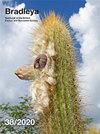关于肯尼亚芦荟复合体(沥青科)的一个新组合的说明
IF 1.2
4区 生物学
Q3 PLANT SCIENCES
引用次数: 0
摘要
概述:芦荟、兰氏芦荟和图根芦荟在形态和叶片分泌物化学方面非常相似,但在肯尼亚北部占据不同的地理位置。在这里,它们被视为一个物种的亚种,A.archeri是最早的名称。图根芦荟已经降为亚种级,新组合A.archeri亚种。这里提出了rendilliorum。提供了一个识别密钥。与东非的其他三个物种一起,它们可能是当地的新特有类群。本文章由计算机程序翻译,如有差异,请以英文原文为准。
Notes on the Aloe archeri complex (Asphodelaceae) in Kenya, with a new combination
Summary: Aloe archeri, A. rendilliorum and A. tugenensis are very similar in morphology and leaf exudate chemistry but occupy separate geographical locations in northern Kenya. Here they are treated as subspecies of one species, for which A. archeri is the earliest name. Aloe tugenensis had already been reduced to subspecies rank, and the new combination A. archeri subsp. rendilliorum is proposed here. An identification key is provided. Together with three other species in eastern Africa they are possibly a local neoendemic group.
求助全文
通过发布文献求助,成功后即可免费获取论文全文。
去求助
来源期刊

Bradleya
PLANT SCIENCES-
CiteScore
2.80
自引率
25.00%
发文量
43
审稿时长
>12 weeks
期刊介绍:
Bradleya is the BCSS contribution to the scientific world and is accepted as such because of its academic standards. It can only flourish with the support of BCSS members, many of whom subscribe to it each year. The aim is to include articles which our members will find interesting and educational, whilst retaining rigorous standards of publication. Scientifically important articles don''t have to be dull to read. So, because Bradleya depends the subscriber, the editor endeavours to make its contents accessible, easily understood and enjoyable for all.
 求助内容:
求助内容: 应助结果提醒方式:
应助结果提醒方式:


